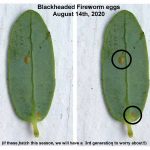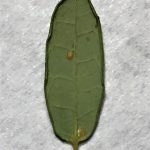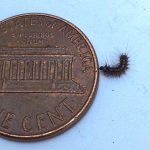Maine Cranberry Pest Reports (2019-2025)
2025 Reports:
July 1st update: Another site that was visited on June 25th had heavy levels of Blackheaded fireworm larvae present and a few of the resulting moths were picked up as well (from some of the first ones out of the gate that must have already transformed to the adult stage). There was a a lot of damage throughout the acreage, including some of the characteristic brownish-red areas where it looked like large areas of the beds had been burned by a fire. Sweepnet counts were upwards of 30, 40 and even 80 times higher than the threshold in some areas. [The threshold is an average of just 1 to 2 per set of 25 sweeps]
More Blackheaded fireworm larvae were found in Columbia Falls on June 12th in fairly high numbers. It appears that fireworm is thriving this year!
Upon the first field visit of the season, on June 4th, in the midcoast area, Blackheaded fireworm larvae were found at two out of two sites that were visited, and in very high numbers at one of those two sites. They looked to be about a week old in their developmental stage.
2023 & 2024 Reports:
Not enough sites were visited in 2023, nor frequently enough, for any pest reports to be deemed very useful to the growers, collectively, as each cranberry site and operation is so different, and with many miles separating most of you (so timings of various pest stages can be wildly different). But if anything out of the ordinary had been found, pest or otherwise, which might have been beneficial for all of the growers to be made aware, a notice would certainly have been posted here as well as sent out by email to growers. ‘No news’ truly is ‘good news,’ in this case.
2022 Reports:
Summary for 2022: Blackheaded fireworm was really the only significant pest problem I encountered anywhere all season. Four locations, in total, had outbreaks of the fireworm to contend with. The fireworm won the battles for this year at two of those locations. Another problem we faced this season was the very dry conditions. A few of the locations I visited had some heat stress occurring; it was severe enough at one location that much of the crop was cooked, unfortunately, while the uprights were blooming.
Happily I have still not found any scale insects that have been a significant headache for our Massachusetts neighbors to the south.
Cranberry tipworm made a late push in the middle of the season, but even the sites with significant tip damage did not appear to have had any impact on this year’s yields. That’s not to say that next year’s buds (vegetative versus flowering buds) won’t be negatively affected, but I don’t believe the tipworm is hurting our yields as much as it seemed to be in the past.
Keeping Quality Forecast for 2022. With 16 possible points to be awarded for the forecast model, using weather conditions from the NWS for Bangor and Caribou, Bangor finished with 7 points and Caribou with 12 points.
- A total of 7 points is “GOOD” = Can ‘probably’ spray a fungicide just once and no more than twice (definitely spray no more than twice if you used a Late Water flood)
- A total of 12 points is “EXCEPTIONAL” = Can ‘probably’ eliminate your fungicide applications (definitely eliminate if you used a Late Water flood this season)
June 17th: Sorry for the late start to the reports this year; that’s partly because I’ve not had very many outings yet this season. Happily, I’ve not found much of note as yet, either, except for fireworm at one of the four locations I’ve visited thus far. Three of the four locations have had very low–even zero in some cases–insect pest numbers, I’m pleased to report.
2021 Reports:
May 25th: Heavy populations of Blackheaded fireworm larvae are present in coastal Washington County today and presumably they would be out now at all of our cranberry locations, so make sure you are on your guard and looking for them. Just 1 or 2 of them is still regarded as the ‘threshold’ in 25 sweeps. Many of them that I found were extremely tiny — less than 24 hours old I’m sure. So this is the ideal time to control them, if you need to.
May 20th: Visited a site today with several acres and found very little; everything was well below threshold levels, in part because the bogs were all under water until last week. Still, it’s always nice to find an absence of any insect outbreaks. The only critters found were a few spongy moth caterpillars, a few cranberry weevils, and a few caterpillars that were possibly false armyworm larvae but they were too small to be certain.
May 13th: Many of the early-season caterpillars were just starting out, in the midcoast part of Maine. Blackheaded fireworm larvae were present, just at the threshold level (2 in 50 sweeps) at one location (of two locations visited). Cranberry blossomworm numbers were four times over the threshold at one of the locations. False armyworm numbers were low (just 1 in 50 sweeps at one location). One Cranberry Weevil was also found at one of the locations, in 50 sweeps (well below the threshold of 4.5 per 25 sweeps). One of the two locations was checked again by the grower on May 18th, and still only one False Armyworm was found and no other pests, in 50 sweeps (very encouraging).
2020 Reports:
August 21st: Redheaded flea beetle levels are very high at some downeast locations currently. The other pest concern right now continues to be Blackheaded fireworm and whether the eggs being laid now by the 2nd-generation moths will hatch this season or not. I have some of the eggs with me and have been checking them every day and hoping they don’t hatch before the end of this season because nobody wants to see a third generation of them!
- Blackheaded Fireworm eggs (found on-site) from Warren, ME on August 14th
- The same two eggs shown at LEFT, still unhatched as of August 19th
July 31st: (email sent to growers): Not everyone is guaranteed to have some, but, I wanted to send this notice to at least inform everyone that starting midweek this week, blackheaded fireworm larvae are present again along the coast, downeast. Look for them in your sweepnets, and/or you can look for patchy, brownish areas where there are uprights loosely (sometimes tightly) pulled and webbed together, with leaves that have been skeletonized, and bits of tiny brown frass on the leaves and webbing. All telltales signs.
These larvae constitute the 2nd generation. And I believe the 2nd generation has already come and gone, in other parts of the state, but just like last year I think there’s a chance we could see a third generation in those regions.
July 14th: (email sent to growers): The ingredients that go into the Keeping Quality model are now complete. With 16 possible points to be awarded for the forecast model, using weather conditions from the NWS for Bangor and Caribou, Bangor finished with 7 points and Caribou with 9 points.
- A total of 7 points is “GOOD” = Can ‘probably’ spray a fungicide just once and no more than twice (definitely spray no more than twice if you used a Late Water flood)
- A total of 9 points is “VERY GOOD TO EXCELLENT” = Can ‘probably’ eliminate your fungicide applications or spray no more than once (definitely eliminate if you used a Late Water flood)
June 26th: The Preliminary Keeping Quality Forecast is ready. Bangor’s weather conditions translate in the model to 6 points which yields a forecast that has already achieved a rating of “Fair to Good” and which could possibly improve, depending on June’s final numbers for temperature and precipitation. Using Caribou’s conditions, the forecast is even better: 8 points and a rating that is already “Good” and which could only get better once June’s weather numbers are available. Massachusetts, by way of interest and comparison, finished with 7 points and a rating of “Good” for their Final 2020 Keeping Quality Forecast.
As far as how to manage for fruit rot in accordance with those ratings, a rating of “Fair to Good” means that you should probably not reduce your fungicide rates and/or the number of fungicide applications, unless you employed ‘Late Water’ this year in which case you can reduce your fungicide inputs. A rating of “Good” means you can probably spray a fungicide just once and no more than twice (definitely spray no more than twice if you used a Late Water flood this year).
June 19th: First-generation Blackheaded fireworm has now mostly completed its life cycle, from the pupation stage all the way through to the adult moth emergence. The moths that are residing in the vines now (for anyone who was unlucky enough to have them this season and was unable to control them), will be mating and laying the eggs that will set the second generation into motion next month. Other than some very small, miscellaneous spanworms and the occasional Spongy moth caterpillar, there isn’t much additional insect pest pressure–at the locations I have visited–to be concerned about right now. I haven’t even seen any cranberry tipworm yet this season, which is remarkable.
June 10th: First-generation Blackheaded fireworm continues to hog the limelight, and has caused headaches at a minimum of five locations so far this season, and has occupied much of my time and focus. The first generation of larvae are quickly maturing and have even begun to pupate in the warmer regions of the state (south-central, and western). False armyworm has been above threshold so far at only a single location (downeast) of the ten locations I’ve visited thus far statewide. False armyworm numbers (when added to Cranberry blossomworm numbers) have been right around the threshold (sometimes just below and sometimes just above), at a handful of locations, but fireworm remains the most troubling insect threat to our cranberry industry currently in my view. I have not noticed any Cranberry tipworm yet this season anywhere I have visited. In recent years it seems that tipworm has quietly faded into obscurity while blackheaded fireworm has taken over as Public Enemy #1. Also, no scale insects yet detected on any of our Maine cranberry vines, nor do I expect to find any.
May 29th: UMaine cranberry pest-scouting was done on six acres in a warmer region of the state yesterday, and blackheaded fireworm larvae were just beginning to hatch on two of the acres and the threshold was slightly surpassed on one of the beds (1 acre; average of 1.5 larvae per 25 sweeps was found and the threshold is one per 25 sweeps). Low numbers, but, they don’t get caught in the net easily and they also couldn’t have been more than a day old, which means more of them are probably coming soon at that location. Even though it was a warmer part of the state, the fireworm hatch was likely delayed at that site by several or more days because the beds were left under water until the middle of May. Also found was a handful of cranberry weevils, a few cranberry blossomworms, a few false armyworms, and some more young spongy moth caterpillars. Unless wet weather and fungal disease ramps up, it’s possible that Maine might see quite a lot of spongy moth this year, based on how frequently they are being found on the cranberries already this season.
- Early instar Spongy moth caterpillar (5/28/2020)
- Cranberry weevil adult (5/28/2020)
May 26th: UMaine cranberry pest-scouting was done on three sites in coastal Washington County today and the insect findings were remarkably similar at all three sites: zero blackheaded fireworm larvae in 300 total sweeps across six different beds (happy with that result, although there was a report from Washington County of fireworm larvae being found during the weekend), but there was a smattering of newly-hatched ‘other’ caterpillars at each site, enough to cumulatively be close to the threshold level of 4.5 per 25 sweeps. There is still plenty of time, however, to better assess the situation with the ‘other’ caterpillars (specifically Cranberry blossomworm, false armyworm, and spongy moth), before they become a potential threat. Next week should provide a clearer picture of the populations of those caterpillars. The other species don’t pose nearly as much danger compared to fireworm, as the others only have a single generation per year (instead of two) and don’t develop as quickly compared to the fireworm.
May 23rd: Blackheaded fireworm larvae are hatching at a very high rate as of today, in the south-central part of the state (Knox County) so I would expect the same for western Maine and certainly anywhere from Troy southwards. Probably Washington County will be seeing fireworm in just another day or two as well, due to the nice stretch of weather we’ve had. The fireworm level was very high at the Knox County location. Cranberry blossomworm, false armyworm, and spongy moth caterpillars were also found. Of those, only the blossomworm was above threshold. But, it appears that essentially all of our early-season caterpillar pests are coming out more or less at the same time, with the cranberry menu being limited mostly to buds right now (which is not a good situation).
May 18th: The first UMaine cranberry pest-scouting visits of the season were made today, at two sites — one in Waldo County and one in Knox County; was on the lookout for newly-hatched blackheaded fireworm larvae but none were found as yet — still a little early, but it’s better to be too early than too late when it comes to blackheaded fireworm. The next visit will probably be made on Thursday or Friday to the Knox County site again, since there was a very high population of 2nd-generation fireworm at that site last season that survived to the moth stage (thus, we are fearful of a large 1st-generation population of the fireworm at that location this season and don’t want to miss the control window). No cranberry insect pests were found today at all except for one tiny caterpillar at the Waldo County site (probably a false armyworm larva).
2019 Reports:
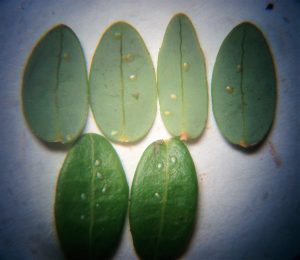
September 18th: It is safe to say at this point, that any fireworm eggs from the 2nd generation of adults are in fact not hatching before the spring! There was one fireworm site I visited, however, on August 26th, where it appeared that a small portion of the eggs must have actually hatched, because there were ‘some’ small fireworm larvae present, long after the 2nd generation had taken place. This might serve as an early warning for us that “3rd-generation fireworm” will be a reality for us in Maine throughout the coming years.
August 23rd: Happy to report that the 3rd-generation of blackheaded fireworm eggs still are not hatching! With colder nights now in the forecast, and September approaching quickly, the eggs might very well remain unhatched until the spring (phew!).
August 21st: The 3rd-generation of blackheaded fireworm eggs that are being monitored daily are not–as yet–hatching! Everyone is hoping the situation remains that way for the duration of this season!
August 16th: There is the real possibility of a third generation of blackheaded fireworm this season, as 2nd-generation moths are already laying their eggs, with half of August still to go! Eggs (from collected moths that are now in captivity) are being monitored daily, to see if they hatch. Updates will be shared here, and via emails with growers. Redheaded flea beetle levels are rising, which is the normal time (August and into September) that their populations increase. Cranberry fruitworm is definitely with us, and isn’t very hard to find on any of the beds, but levels seem to be tolerable (or at least typical) thus far.
August 1st: The 2nd generation of fireworm is definitely with us now — earlier reports were correct. Most of the larvae found are mature and some looked to be in their pre-pupal stage. Not everyone has them (some were lucky enough to get good control of the first generation, and/or previous seasons’ generations, such that it’s not an issue right now). For those of you who were not so fortunate, and with a lot of summer weather still to come, keep in mind that perhaps a 3rd generation will squeak out as well before it’s all over. Other pests: Some redheaded flea beetles and blunt-nosed leafhoppers were found on July 31st, downeast (Washington County), so those pests are now active as well and right on time. Generally their populations rise throughout August and September, so be watching for those. Don’t be alarmed unless you start finding a great many of them, consistently (on the order of 50 to 100 or so per 25 sweeps). Tipworm continues to be pretty low, and although there was a site on July 31st with maybe 10% of tips damaged from tipworm, there were no maggots or pupae that were found in several tips that were examined at the site, and no tipworm flies were in the sweep net, either, so they don’t appear to be ballooning out of control like they used to in the past. Fireworm is demanding most of the attention this season, and the 2nd generation has done some tremendous harm to the vines and to the yields at a few locations. Next up is cranberry fruitworm, of course. One fruitworm-infested berry was found already earlier this week (July 29th), in Calais. Fruitworm could be at a high level this season due to the favorable weather conditions (warm nights, especially). No scale insects have yet been found at any of the Maine sites. Bee levels and fruit set have been looking really good!
July 25th: The 2nd generation of blackheaded fireworm is gearing up (larvae were found in the Augusta area, and downeast there are reports of moths at one location and larvae at another). Anyone using Altacor® or Exirel® for fruitworm (which should be applied at 50% out of bloom), should simultaneously obtain great fireworm control because it works very well on both of those pests (it has a very long residual which helps a lot).
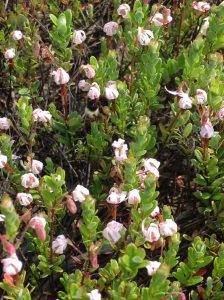
July 15th: No concerning pest problems to report! Bloom looks heavy, but bee levels on the beds do not look heavy, so that is a bit concerning. Bumblebee numbers on the beds seem to be higher than the honey bee levels, so far, and the native bumblebee numbers don’t seem as robust as the last few years, either.
The second generation of Blackheaded fireworm larvae has not begun as yet, or at least no 2nd-generation larvae have yet been found by our cranberry staff. They should be present by the end of July, for any site where there was much of a first generation, and assuming that some of them survived long enough to reach adulthood.
July 2nd: Blackheaded fireworm is now between generations, with moths on the beds mating and laying eggs for the 2nd generation. The eggs are deposited, singly, on the undersides of the leaves, so it’s not practical to try to find any of the eggs yourself. The second generation of larvae should begin to show up by the middle of July, if your location happened to give rise to some of the moths (each mated female can lay up to 200 eggs). Cranberry tipworm continues to be at very low levels (no more than 5% of tips being infested, at any of the sites monitored thus far). Very few insect pests, overall, are being found on the beds at this point (in terms of number of species), which is great! The important thing now is to order up some nice, sunny days to get us through the bloom/pollination period. Many sites have heavy blossom loads!
The Final Keeping Quality Forecast is ready. Both Bangor and Caribou finished with 5 points out of 16 which somehow still translates to a forecast of “Fair to Good” (same forecast result as last year). This forecast in the model translates to the following interpretation:
You should probably not reduce your fungicide rates and/or the number of fungicide applications. If Late Water was held, you can reduce your fungicide inputs in that situation. Keeping Quality Forecast (pdf) | Keeping Quality Forecast (MS Word)
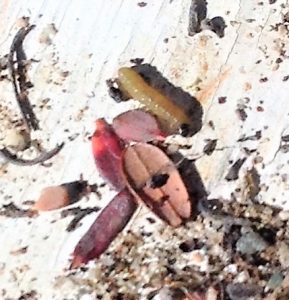
June 20th: Blackheaded fireworm is still causing some big headaches in the state, and first-generation larvae are still showing up, even in western Maine, suggesting that the egg-hatch has been significantly prolonged and asynchronous this season! This is the latest time in June for them, in fact, that Maine has recorded, for 1st-generation blackheaded larvae to still be emerging (with the exception of possibly 2006). No fireworm moths have been found at any of the sites thus far this season, which provides proof that the ‘late’ fireworm larvae found yesterday in western Maine are not 2nd-generation larvae (a lot of fireworm moths would be on the beds if that was the case, because they do not die that quickly).
Not many other insect pests have been showing up this week (only a few cranberry weevils now and then, an occasional spongy moth larva, some blossomworm, and still almost no tipworm). I’ve not found any site as yet with more than 5% of uprights with tipworm maggots inside. Quite remarkable! False armyworm larvae have been at surprisingly low levels this season as well.
Preliminary Keeping Quality Forecast: The preliminary cranberry keeping quality forecast through the end of May is at the ‘Fair’ to ‘Good’ level using Bangor conditions and ‘Poor’ if using Caribou conditions. Caribou has gotten only 4 points thus far out of 13 and Bangor has only one point higher, with 5. The forecast can be completed at the end of June.
June 11th: Very high numbers of Blackheaded fireworm and Blossomworm larvae to report now, for this week, for at least some of the Columbia Falls growers as of yesterday! With the first truly ‘hot’ day of the season, the caterpillar pests are trying to take advantage and are trying to make up for lost time, essentially. Many of the fireworm larvae looked like they had just hatched, and couldn’t have been older than a day or even a few hours in some cases.
Other Notes:
- Once again, the timing of young mare’s tail plants around the margins of the cranberry beds is coinciding with the emergence of the blackheaded fireworm larvae, so bear that in mind in future years.
- Note about Cranberry tipworm: none found as yet even though this is when the eggs and larvae should be appearing; a sample of 40 brand new tips collected on June 10th from a historically ‘high tipworm’ site in Washington County were examined today–June 11th–but no eggs or larvae were present.
- High populations of Meadowsweet plants on some of the beds in Washington County right now.
- Preliminary Keeping Quality Forecast: Coming Soon!
June 5th: Blackheaded fireworm and False armyworm caterpillars were found in the midcoast/Lincolnville area today. So both of these pests should be starting for everyone by the end of this week if they haven’t already begun where you are. I would suggest taking 50 sweeps (twice the minimum of 25, for added thoroughness) on each bed you wish to check, and then very carefully examining the net contents, because the fireworm larvae in particular are very small and they are easy to overlook at first. Look for their shiny, dark (black) heads, and the backwards wiggle dance that they do when disturbed. Remember, blackheaded fireworm goes through two generations each season, so the best chance one has at keeping them out of the equation, is to control the first generation before they can produce any offspring.
May 31st: Visited western Maine; zero pests found but beds had been sprayed so I cannot as yet say what the insects are doing independent of chemicals. Mare’s tail plants were present, which in the past has often corresponded to the start of blackheaded fireworm and cranberry tipworm. I will be visiting more sites the week of June 2nd.
May 24th: Have visited three locations thus far (one downeast on May 11th and two yesterday in central/midcoast areas), and have found zero pests thus far. The spring season is certainly on the slow side this year.
Disclaimer: Pesticide registration status is subject to change and varies from state to state; therefore the author and the University of Maine Cooperative Extension cannot assume liability for any pesticide recommendations. It is the responsibility of the pesticide applicator to verify the registration status of any pesticide before applying it. The label is the law! Always read and follow the label when applying pesticides. Use of product names does not imply endorsement.

